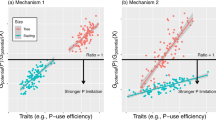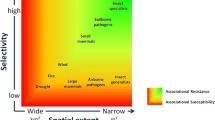Abstract
Inhibition of canopy tree recruitment beneath thickets of the evergreen shrubs Rhododendron maximum L. and Kalmia latifolia L. has long been observed in Southern Appalachian forests, yet the mechanisms of this process remain unresolved. We present a first-year account of suppression of oak seedlings in relation to Rhododendron and Kalmia basal area, light and resource availability, seedling performance and the rates of seedling damage (i.e., herbivory). We found no evidence of first-year seedling suppression or significant resource deficiencies beneath thickets of K. latifolia in mature mixed hardwood stands. Suppression beneath R. maximum was apparent during the first growing season. We found that seedling biomass, light availability prior to canopy closure, and seedling tissue C:N ratios were negatively correlated with R. maximum basal area. Basal area of R. maximum was positively correlated with seedling mortality rates, soil [Al], and early-growing season leaf herbivory rates. Seedling growth was positively correlated with light and tissue C:N, while negatively correlated with soil [Al]. Overall, our results support the inhibition model of shade-mediated carbon limitation beneath dense understory shrubs and indicate the potential importance of herbivory and aluminum toxicity as components of a suppression mechanism beneath R. maximum thickets. We present a causal model of first year inhibition beneath R. maximum in the context of our findings and the results of prior studies.
Similar content being viewed by others
References
T.T. Baker D.H. Van Lear (1998) ArticleTitleRelations between density of rhododendron thickets and diversity of riparian forests Forest Ecology and Management 109 21–32 Occurrence Handle10.1016/S0378-1127(98)00259-X
B. Beckage J.S. Clark B.D. Clinton B.L. Haines (2000) ArticleTitleAlong term study of tree seedling recruitment in southern Appalachian forests: the effects of canopy gaps and shrub understories Canadian Journal of Forest Research 30 1617–1631 Occurrence Handle10.1139/cjfr-30-10-1617
S.E. Boettcher P.J. Kalisz (1990) ArticleTitleSingle-tree influence on soil properties in the mountains of eastern Kentucky Ecology 71 1365–1372
J.P. Bryant FS Chapin SuffixIII. (1986) Browsing-woody plant interactions during boreal forest plant succession.. In: Van Cleve K FS Chapin SuffixIII. P.W. Flanagan L.A. Viereck C.T. Dyrness (Eds) Forest Ecosystems in the Alaskan taiga. Springer-Verlag New York, USA 213–225
C.D. Canham (1988) ArticleTitleGrowth and canopy architecture of shade tolerant trees: the response of Acer saccharum and Fagus grandiflora to canopy gaps Ecology 69 786–795
B.D. Clinton J.M. Vose (1996) ArticleTitleEffects of Rhododendron maximum L. on Acer rubra L. seedling establishment Castanea 61 38–45
B.D. Clinton L.R. Boring W.T. Swank (1994) ArticleTitleRegeneration patterns in canopy gaps of mixed-oak forests of the southern Appalachians: influences of topographic position and evergreen understory American Midland Naturalist 132 308–319
P.D. Coley J.P. Bryant F.S.III Chapin (1985) ArticleTitleResource availability and plant antiherbivore defense Science 230 895–890
M.M. Dobbs (1995) Spatial and temporal distribution of the evergreen understory in the Southern Appalachians. MS Thesis University of Georgia Athens Georgia USA
J.S. Denslow E. Newell A.M. Ellison (1991) ArticleTitleThe effect of understory palms and cyclanths on the growth and survival of Inga seedlings Biotropica 23 225–234
J.F. Dudt D.F. Shure (1994) ArticleTitleThe influence of light and nutrients on foliar phenolics and insect herbivory Ecology 75 86–98
C.D. Foy (1983) ArticleTitleThe physiology of plant adaptation to mineral stress Iowa State Journal of Research 57 339–354
M.E. Hanley (1998) ArticleTitleSeedling herbivory, community composition and plant life history traits Perspectives in Plant Ecology, Evolution and Systematics 1 191–205
Horsley S.B. (1988). How vegetation can influence regeneration. In: Clay S.H., Perkey A.W., Kidd W.E. Jr. (ed). Guidelines for regenerating Appalachian hardwood stands: Workshop proceedings, 1988, May 24-26. Morgantown, WV. Society of American Foresters Publ. 88-03. West Virginia University Books, Morgantown, West Virginia, USA, pp. 38–54
R.K. Kobe S.W. Pacala J.A. Silander C.D. Canham (1995) ArticleTitleJuvenile tree survivorship as a component of shade tolerance Ecological Applications 5 517–32
A.U. Mallik (1995) ArticleTitleConversion of temperate forests to heaths – role of ecosystem disturbance and ericaceous plants Environmental Management 19 675–684
Marquis D.A., Ernst R.L. and Stout S.L. (1984). Prescribing silvicultural treatments in hardwood stands of the Alleghenies. Gen- .Tech. Rep. NE-96. U.S. Department of Agriculture, Forest Service, Northeastern Forest Experiment Station, Broomall, Pennsylvania, USA, 90 p
McGinty D.T. (1972). The ecological roles of Kalmia latifolia L. and Rhododendron maximum L. in the hardwood forest at Coweeta. Ms. Thesis. University of Georgia, Athens Georgia USA, 81 p
C.D. Monk D.T. McGinty F.P. Day SuffixJr. (1985) ArticleTitleThe ecological importance of Kalmia latifolia and Rhododendron maximum in the deciduous forest of the southern Appalachians Bulletin of the Torrey Botanical Club 112 187–193
E.T. Nilsen J.F. Walker O.K. Miller S.W. Semones T.T. Lei B.D. Clinton (1999) ArticleTitleInhibition of seedling survival under Rhododendron maximum (Ericaceae): could allelopathy be a cause? American Journal of Botany 86 1597–1605 Occurrence Handle10562250
E.T. Nilsen B.D. Clinton T.T. Lei O.K. Miller S.W. Semones J.F. Walker (2001) ArticleTitleDoes Rhododendron maximum L Ericeaceae. reduce the availability of resources above and belowground for canopy tree seedlings?. American Midland Naturalist 145 325–343
S.W. Pacala C.D. Canham J.A. Silander SuffixJr. R.K. Kobe (1994) ArticleTitleSapling growth as a function of resources in a north temperate forest Canadian Journal of Forest Research 24 2172–2183
Rich P.M. (1989). A manual for analysis of hemispherical canopy photography. Los Alamos National Laboratory, Los Alamos, N.M. Publ. LA-117733-M
J.R. Runkle (1982) ArticleTitlePatterns of disturbance in some old-growth forests of the eastern United States Ecology 62 1041–1051
S.W. Semones (1999) Inhibition of canopy tree seedlings by thickets of Rhododendron maximum L. (Ericaceae) in an eastern deciduous forest. Ph.D. Dissertation Virginia Tech Blacksburg, Virginia, USA
W.T. Swank D.A. Crossley (1988) Forest hydrology and ecology at Coweeta Springer Verlag New York, New York, USA 469
A.G. Thompson G.L. Radford D.A. Norris J.E.G. Good (1993) ArticleTitleFactors affecting the distribution and spread of Rhododendron in north Wales Journal of Environmental Management 39 199–212 Occurrence Handle10.1006/jema.1993.1064
T.T. Veblen (1982) ArticleTitleGrowth patterns of Chusquea bamboos in the understory in Chilean Nothofagus forest and their influences in forest dynamics Bulletin of the Torrey Botanical Club 109 474–487
J.F. Walker O.K. Miller T.T. Lei S. Semones E.T. Nilsen B.D. Clinton (1999) ArticleTitleSuppression of ectomycorrhizae on canopy tree seedlings in Rhododendron maximum L. (Ericaceae) thickets in the southern Appalachian mountains Mycologia 9 49–56
M.B. Walters E.L. Kruger P.B. Reich (1993) ArticleTitleRelative growth rate in relation to physiological and morphological traits for northern hardwood seedlings: species, light environment and ontogenetic considerations Oecologia 96 219–231 Occurrence Handle10.1007/BF00317735
M.B. Walters P.B. Reich (1996) ArticleTitleAre shade tolerance, survival and growth linked? Low light and nitrogen effects on hardwood seedlings Ecology 77 841–853
T.C. Whitmore (1989) ArticleTitleCanopy gaps and the two major groups of forest trees Ecology 70 536–538
Author information
Authors and Affiliations
Corresponding author
Rights and permissions
About this article
Cite this article
Beier, C.M., Horton, J.L., Walker, J.F. et al. Carbon limitation leads to suppression of first year oak seedlings beneath evergreen understory shrubs in Southern Appalachian hardwood forests. Plant Ecol 176, 131–142 (2005). https://doi.org/10.1007/s11258-004-0119-9
Received:
Accepted:
Issue Date:
DOI: https://doi.org/10.1007/s11258-004-0119-9




